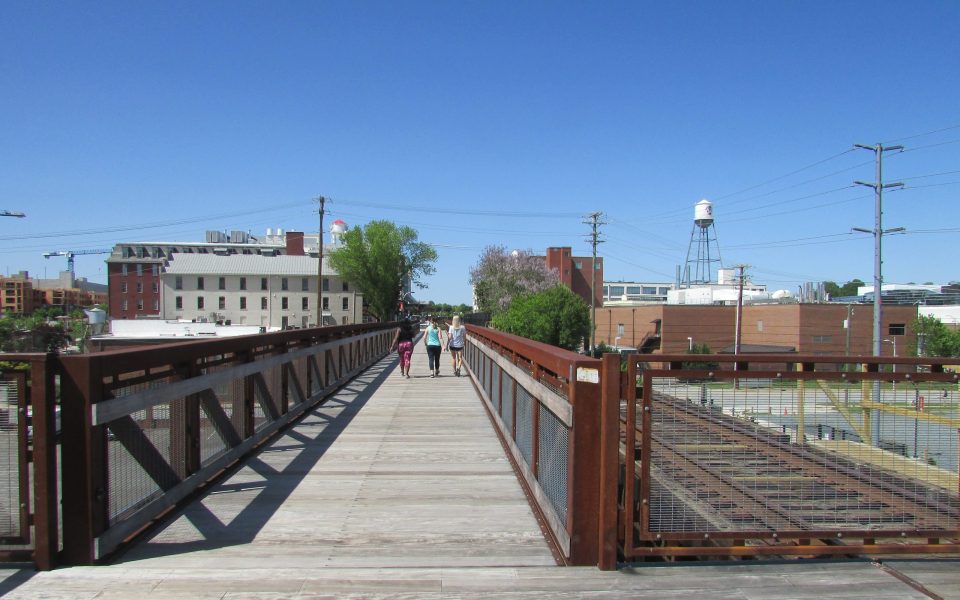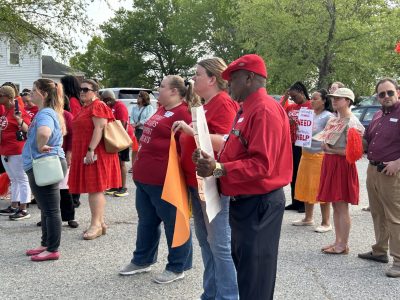The Long Branch Trail, which opened last month in Wake Forest Innovation Quarter, follows the path of a discontinued rail line.
The RJ Reynolds Building provided the iconic art-deco model for the larger Empire State Building, so it’s only fair that Winston-Salem is stealing the High Line concept — a linear public park made from a reclaimed raised railbed — from New York City.
The Long Branch Trail, which spans the 1.7-mile length of Wake Forest Innovation Quarter from Martin Luther King Jr. Drive at the north end to Rams Drive in the south, officially opened last month on a discontinued Norfolk-Southern rail line.
“On a Winston-Salem scale, this is our version of [the High Line],” said Graydon Pleasants, head of real estate development for the Innovation Quarter.
The paved multi-use trail uses the original rail bridges over Third, Fourth, Fifth and Seventh streets, providing a grade separation above the street grid that gives strollers, runners and cyclists a panoramic view of the downtown skyline. The original rail bridges, one of which dates back to 1916, still accommodate a single rail line that runs parallel to the trail from Third Street to 27th Street. Pleasants said the NC Department of Transportation Rail Division purchased the rail corridor from Norfolk-Southern, and it could potentially serve as a future light-rail or trolley line.
“They’ve been good partners to us,” he said.
The Long Branch Trail, named after a vanished African-American neighborhood, runs along the back side of a string of buildings, part of the historic Reynolds tobacco works complex, that are now occupied by tech workers and graduate students. As the trail runs past Inmar, 525@Vine, Wake Forest University School of Medicine and Piedmont Leaf Lofts, it has the feel of a railway platform.
True to its purpose, the Long Branch Trail connects the Innovation Quarter to the city at large. A monument at the northern terminus at Martin Luther King Jr. Drive announces the path at the trailhead adjacent to the Downtown Health Plaza, a facility that provides services to people from across the city. And at the south end of the trail at Rams Drive, a connector trail developed by the NC Department of Transportation links the Long Branch Trail to Salem Lake Trail.
The Long Branch Trail also charts a path through the largely undeveloped south district of the Innovation Quarter, an expanse of fields and ponds wedged between North Patterson Avenue and Highway 52, with the Center for Design Innovation planting an outpost on Rams Drive. The Long Branch Trail will eventually connect to a planned multi-use path running along Business 40 to Baptist Hospital.
Karla Barnes and Mike Faurote, who work together in Inmar’s corporate communications division, frequently use the trail for what Barnes calls “meeting walks.”
“It clears your head,” Faurote said.
“It gives to the city another perspective,” Barnes added. “It brings life.”
Inmar, a data analytics company that helps optimize operations involving coupons, prescriptions and product returns, maintains a bike rack for its employees.
“In the time it takes for lunch, you can bike to Salem Lake and back,” Faurote said.
Although the Long Branch Trail is open to the public as part of a pedestrian network that traverses the city, it’s maintained by the Innovation Quarter. Pleasants said the trail was built with funds from multiple sources, including state and federal government, the city of Winston-Salem, Wake Forest University and Wexford Science & Technology, the company that developed the Innovation Quarter.
The trail boasts a string of benches, platforms, wide stretches and grassy shoulders that invite social gatherings, post-run stretch-downs and potentially even yoga sessions.
Those amenities are inspiring staff to step up their programming, according to a story published on the Innovation Quarter’s storytelling platform, The Hub.
“We’re really thinking about programming more holistically,” said Lindsey Schwab, director of community relations for the Innovation Quarter. “It is another step toward providing outdoor programming around health and wellness, but we’re also exploring what kinds of opportunities it creates for building relationships between neighborhoods and within the entire Winston-Salem community.”
Join the First Amendment Society, a membership that goes directly to funding TCB‘s newsroom.
We believe that reporting can save the world.
The TCB First Amendment Society recognizes the vital role of a free, unfettered press with a bundling of local experiences designed to build community, and unique engagements with our newsroom that will help you understand, and shape, local journalism’s critical role in uplifting the people in our cities.
All revenue goes directly into the newsroom as reporters’ salaries and freelance commissions.





Leave a Reply